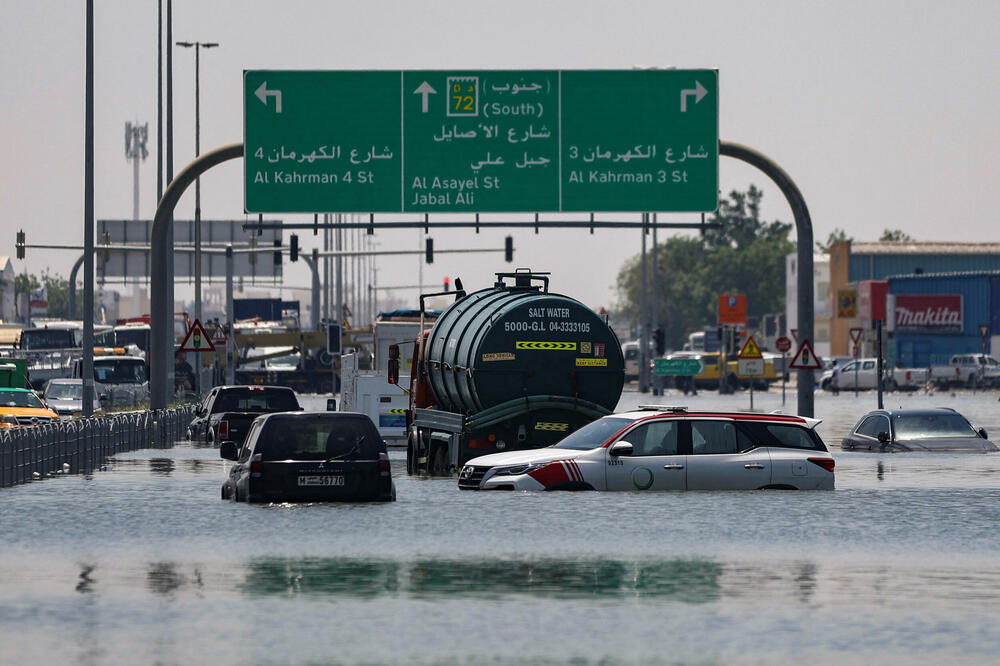The storm hit the United Arab Emirates and Oman this Sunday, bringing record rainfall that flooded highways and homes, blocked traffic and trapped people in their homes.
According to reports, at least 20 people died in the floods in Oman, while another person died in the UAE, where government offices and schools were closed for days due to flooding.
The storm initially hit Oman on Sunday, before reaching the UAE on Tuesday, causing power outages and massive air traffic disruptions as runways turned into rivers.
Al Ain, on the border of the UAE and Oman, recorded a record 254 millimeters of rainfall. This is the highest amount of precipitation in a 24-hour period since measurements began in 1949.
Did cloud seeding cause the storm?
Rainfall is rare in the UAE and elsewhere in the Arabian Peninsula, which is known for its dry desert climate. Summer air temperatures can rise above 50 degrees Celsius.
However, the UAE, like Oman, has no drainage systems to carry water away during heavy rains, so flooded roads are not uncommon there during rainfall.
After Tuesday's rainfall, questions were raised about whether cloud seeding, a process often used by the UAE, could have caused the heavy rains.
Cloud seeding is the process of injecting chemicals into clouds to increase precipitation in a water-scarce environment.
The United Arab Emirates, located in one of the hottest and driest regions on Earth, is among the leading countries in cloud seeding and increasing rainfall.
However, the UAE Meteorological Agency told Reuters that there were no such operations before the storm.
And climate change?
The heavy rainfall was likely the result of a normal weather system exacerbated by climate change, experts said.
A low-pressure system in the upper atmosphere, along with low pressure at the surface, acted as a "squeeze" on the air, said Esra Alnakbi, a forecaster at the UAE government's National Center for Meteorology.
That squeeze, enhanced by the contrast between warmer temperatures at ground level and cooler temperatures above, created conditions for strong thunderstorms, she said.
The "abnormal phenomenon" is not unexpected in April, as pressure changes rapidly with the change of season, she said, adding that climate change also likely contributed to the storm.
Climatologists say rising global temperatures, caused by human-induced climate change, are leading to more extreme weather events around the world, including intense rainfall.
"Rainfall from thunderstorms, such as those seen in the UAE in recent days, has seen a particularly strong increase with warming. This is because convection, which is the strong updraft in storms, is stronger in a warmer part of the world," said Dim Koumou, professor of climate extremes at the Vrije University in Amsterdam.
Clouds cannot be made out of nothing
Friederike Otto, a lecturer in climate science at Imperial College London, said rainfall around the world is becoming much heavier with global warming because a warmer atmosphere can hold more moisture. It is wrong to talk about cloud seeding as the cause of heavy rainfall, she said.
"Cloud seeding can't make clouds out of nothing. It encourages the water that's already in the sky to condense faster and release the water in certain places. So you need moisture first. Without it, there wouldn't be clouds," she said. .
Global warming has resulted in "extraordinarily" warm water in the seas around Dubai, where there is also very warm air above, said Mark Howden, director of the Australian National University's Institute for Climate, Energy and Disasters.
"That increases both the potential evaporation rates and the capacity of the atmosphere to hold that water, allowing for higher rainfall like what we just saw in Dubai," he said.
Gabi Hegerl, a climatologist at the University of Edinburgh, said extreme rainfall events, such as in the UAE and Oman, were likely to worsen in many places due to the effects of climate change.
When the conditions are perfect for really heavy rain, there is more moisture in the air, so it rains harder. That extra moisture is a result of warmer air, which is a result of human-caused climate change, she said.
Bonus video:










